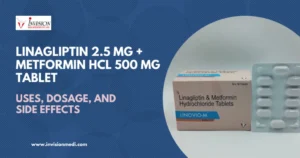
Introduction:
THROMBONEX–10 is a medication containing Rivaroxaban, a novel oral anticoagulant used to prevent blood clots in various medical conditions. This article provides an overview of its uses, mechanism of action, benefits, recommended dosage, and potential adverse reactions and precautions.
Mechanism of Action (MOA):
Rivaroxaban, the active ingredient in THROMBONEX–10, is a direct inhibitor of factor Xa, a crucial component in the coagulation cascade. By selectively binding to factor Xa, Rivaroxaban inhibits the conversion of prothrombin to thrombin, thereby preventing the formation of blood clots.
Uses:
THROMBONEX–10 is primarily prescribed to reduce the risk of stroke and systemic embolism in patients with non-valvular atrial fibrillation, to treat deep vein thrombosis (DVT) and pulmonary embolism (PE), and to prevent recurrent DVT and PE.
Benefits:
The primary benefit of THROMBONEX–10 is its ability to effectively prevent or treat blood clots, reducing the risk of stroke, systemic embolism, DVT, and PE in patients with various medical conditions. Additionally, it offers the convenience of oral administration compared to traditional anticoagulants like warfarin, which require regular monitoring and dose adjustments.
Recommended Dosage:
The recommended dosage of THROMBONEX–10 varies depending on the indication for use. For stroke prevention in atrial fibrillation, the usual dose is 20 mg once daily with the evening meal. For the treatment of DVT and PE, the recommended dose is 15 mg twice daily with food for the first 21 days, followed by 20 mg once daily thereafter. Always follow the dosage instructions provided by your healthcare provider.
Adverse Reactions and Precautions:
Rivaroxaban, the active ingredient in THROMBONEX–10, is generally well-tolerated, but like all medications, it may cause adverse reactions in some individuals. Common side effects include bleeding, bruising, nausea, and headache. Additionally, THROMBONEX–10 should not be used in patients with a history of hypersensitivity to Rivaroxaban or any other components of the formulation, or in patients with active pathological bleeding. Regular monitoring of renal function, liver function, and blood clotting parameters may be necessary in some patients. Always consult your healthcare provider for personalized advice and recommendations regarding the use of THROMBONEX–10.
Conclusion:
THROMBONEX–10 is a valuable medication for the prevention and treatment of blood clots in various clinical settings. By understanding its uses, mechanism of action, benefits, recommended dosage, and potential adverse reactions, patients and healthcare providers can make informed decisions about its use in managing thromboembolic disorders.
Related Combinations:
Explore other cardiovascular medications and combination therapies offered by Invision Medi Sciences to address various aspects of heart health and hypertension management.
Prevent Blood Clots with Confidence: THROMBONEX–10 Tablets
FAQs
What is THROMBONEX–10 used for?
THROMBONEX–10 is primarily used to prevent blood clots in patients with conditions such as atrial fibrillation, deep vein thrombosis, and pulmonary embolism.
How does THROMBONEX–10 work?
THROMBONEX–10 contains Rivaroxaban, which inhibits factor Xa, a key component in the blood clotting process, thereby preventing the formation of blood clots.
What is the recommended dosage of THROMBONEX–10?
The recommended dosage of THROMBONEX–10 varies depending on the indication. For stroke prevention in atrial fibrillation, the usual dose is 20 mg once daily. For deep vein thrombosis and pulmonary embolism treatment, the initial dose is 15 mg twice daily for 21 days, followed by 20 mg once daily thereafter.
What are the common side effects of THROMBONEX–10?
Common side effects of THROMBONEX–10 include bleeding, bruising, gastrointestinal discomfort, and headache. Serious bleeding may occur in some cases, so it’s essential to monitor for signs of bleeding and seek medical attention if necessary.
Can THROMBONEX–10 interact with other medications?
Yes, THROMBONEX–10 can interact with certain medications, including other anticoagulants, antiplatelet drugs, and medications that affect liver function. It’s important to inform your healthcare provider about all medications you are taking before starting THROMBONEX–10 to avoid potential interactions.
Invision Medi Sciences Pvt. Ltd. – Nurturing Health and Innovation:
Invision Medi Sciences Pvt. Ltd. is committed to pushing the boundaries of healthcare innovation. With a focus on precision and efficacy, the company strives to create solutions that not only alleviate symptoms but also contribute to the holistic well-being of individuals. Invision Medi Sciences is a trusted name in the pharmaceutical industry, dedicated to advancing healthcare for a healthier and happier world.


